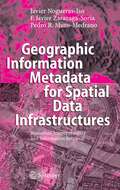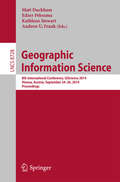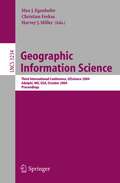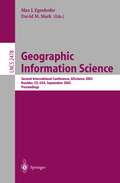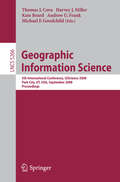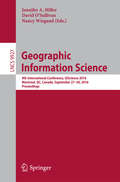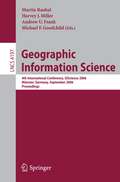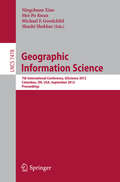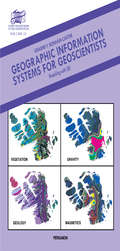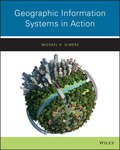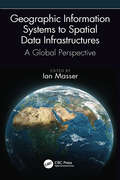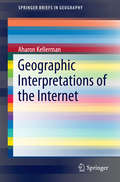- Table View
- List View
Geographic Information and Cartography for Risk and Crisis Management: Towards Better Solutions (Lecture Notes in Geoinformation and Cartography)
by Milan Konecny Temenoujka L. Bandrova Sisi ZlatanovaCartography and geographic information (GI) are remarkably appropriate for the requirements of early warning (EW) and crisis management (CM). The use of geospatial technology has increased tremendously in the last years. ICT has changed from just using maps created in advance, to new approaches, allowing individuals (decision-makers) to use cartography interactively, on the basis of individual user's requirements. The new generation of cartographic visualizations based on standardisation, formal modelling, use of sensors, semantics and ontology, allows for the better adaptation of information to the needs of the users. In order to design a new framework in pre-disaster and disaster management safety/security/privacy aspects of institutions and citizens need to be considered. All this can only be achieved by demonstrating new research achievements, sharing best practices (e.g. in the health area) and working towards the wider acceptance of geospatial technology in society, with the help of education and media. This book will outline research frontiers and applications of cartography and GI in EW and CM and document their roles and potentials in wider processes going on in information/knowledge-based societies.
Geographic Information Metadata for Spatial Data Infrastructures: Resources, Interoperability and Information Retrieval
by Javier Nogueras-Iso Francisco Javier Zarazaga-Soria Pedro R. Muro-MedranoMetadata play a fundamental role in both DLs and SDIs. Commonly defined as "structured data about data" or "data which describe attributes of a resource" or, more simply, "information about data", it is an essential requirement for locating and evaluating available data. Therefore, this book focuses on the study of different metadata aspects, which contribute to a more efficient use of DLs and SDIs. The three main issues addressed are: the management of nested collections of resources, the interoperability between metadata schemas, and the integration of information retrieval techniques to the discovery services of geographic data catalogs (contributing in this way to avoid metadata content heterogeneity).
Geographic Information Science: Mastering the Legal Issues (Mastering GIS: Technol, Applications & Mgmnt)
by George ChoSpatial information users and providers are increasingly concerned about the legal implications relating to the use and dissemination of geographic information for which there are no right or wrong methods of practice, and no one source of information. This book fills the gap by addressing key issues in contract law, intellectual property law, rights and responsabilities and liability as they relate to the GI community. The first book to interpret the law relating to GI Science and outline its implications to a general readership Provides a comprehensive discourse in law and GI Science irrespective of jurisdiction Offers a global perspective throughout with case materials coming from the UK, North America, the EU and Australasia
Geographic Information Science: 8th International Conference, GIScience 2014, Vienna Austria, September 24-26, 2014, Proceedings (Lecture Notes in Computer Science #8728)
by Matt Duckham Edzer Pebesma Kathleen Stewart Andrew U. FrankThis book constitutes the refereed proceedings of the 8th International Conference on Geographic Information Science, GIScience 2014, held in Vienna, Austria in September 2014. The 23 full papers presented were carefully reviewed and selected from various submissions. The papers are organized in topical sections such as information visualization, spatial analysis, user-generated content, semantic models, wayfinding and navigation, spatial algorithms, and spatial relations.
Geographic Information Science: Third International Conference, GI Science 2004 Adelphi, MD, USA, October 20-23, 2004 Proceedings (Lecture Notes in Computer Science #3234)
by Max J. Egenhofer Christian Freksa Harvey J. MillerThis section gives a description of notions used throughout this study. Current achievements in developing action-centered ontologies are also discussed. 2.1 Ontologies In the context of information extraction and retrieval, different kinds of ontologies can be distinguished [15]: • Top-level ontologies describe very general concepts like space and time, not depending on a particular domain, • Domain ontologies and task ontologies describe the vocabulary related to a generic domain or kind of task, detailing the terms used in the top-level ontology, • Application ontologies describe the concepts that depend on the particular domain and task within a specific activity. Several investigations have been conducted to bring actions (tasks) to bear on - tologies. Among them are Chandrasekaran et al. [6] and Mizoguchi et al. [23] in the fields of AI and Knowledge Engineering. For the geospatial domain, Kuhn [21] and Raubal and Kuhn [26] have attempted to support human actions in ontologies for transportation. Acknowledging the importance of human actions in the geographic domain, a research workshop was held in 2002, bringing together experts from diff- ent disciplines to share the knowledge and work on this issue [1]. Camara [5], one of the workshop participants, has proposed that action-driven spatial ontologies are formed via category theory, for the case of emergency action plans.
Geographic Information Science: Second International Conference, GIScience 2002, Boulder, CO, USA, September 25-28, 2002. Proceedings (Lecture Notes in Computer Science #2478)
by Max J. Egenhofer David M. MarkGeographic Information Science: 5th International Conference, GIScience 2008, Park City, UT, USA, September 23-26, 2008, Proceedings (Lecture Notes in Computer Science #5266)
by Andrew U. Frank Michael Goodchild Thomas J. Cova Harvey J. Miller Kate BeardThe GIScience conference series was founded in 2000 with the goal of providing a forum for researchers interested in advancing the fundamental aspects of the prod- tion, dissemination, and use of geographic information. The conference is held bi- nually and attracts people from academia, industry, and government across a host of disciplines including cognitive science, computer science, engineering, geography, information science, mathematics, philosophy, psychology, social science, and stat- tics. Following a very successful conference in Münster, Germany in 2006, this year’s conference was held in Park City, Utah, USA, the prior site of the 2002 Winter Ol- pics and home to the annual Sundance Film Festival. There are two forms of submission to the conference: full papers of 6000 words or less and extended abstracts of 500-1000 words for either a presentation or poster. This format was originally designed to capture the cultural difference between researchers who prefer to publish a peer-reviewed conference paper and those who would rather submit an abstract covering work in progress. This year 77 full papers were submitted and reviewed by 3 Program Committee members, of which 24 were selected for pr- entation and inclusion in this volume. Of the 115 extended abstracts that were subm- ted and reviewed by 2 Program Committee members, 47 were accepted for an oral presentation and 25 were accepted for presentation as a poster. The abstracts were published in a second booklet and are available on the GIScience website (http://www. giscience. org).
Geographic Information Science: 9th International Conference, GIScience 2016, Montreal, QC, Canada, September 27-30, 2016, Proceedings (Lecture Notes in Computer Science #9927)
by Jennifer A. Miller David O’Sullivan Nancy WiegandThis book constitutes the refereed proceedings of the 9th International Conference on Geographic Information Science, GIScience 2016, held in Montreal, QC, Canada, in September 2016. The 21 full papers presented were carefully reviewed and selected from 63 submissions. The papers are organized in topical sections such as spatial algorithms; network analysis; spatial analysis; spatial methods; user-generated data and linked data; automated cartography and geovisualization.
Geographic Information Science: 4th International Conference, GIScience 2006, Münster, Germany, September 20-23, 2006, Proceedings (Lecture Notes in Computer Science #4197)
by Martin Raubal Harvey J. Miller Andrew U. Frank Michael F. GoochildThis book constitutes the refereed proceedings of the 4th International Conference on Geographic Information Science, GIScience 2006. The book presents 26 revised full papers. Among traditional topics addressed are spatial representations and data structures, spatial and temporal reasoning, computational geometry, spatial analysis, and databases. Many papers deal with navigation, interoperability, dynamic modeling, ontology, and semantics. Geosensors, location privacy, social issues and GI research networks rank among the new directions covered.
Geographic Information Science: 7th International Conference, GIScience 2012, Columbus, OH, USA, September 18-21, 2012, Proceedings (Lecture Notes in Computer Science #7478)
by Ningchuan Xiao Mei-Po Kwan Michael F. Goodchild Shashi ShekharThis book constitutes the refereed proceedings of the 7th International Conference on Geographic Information Science, GIScience 2012, held in Columbus, OH, USA in September 2012. The 26 full papers presented were carefully reviewed and selected from 57 submissions. While the traditional research topics are well reflected in the papers, emerging topics that involve new research hot-spots such as cyber infrastructure, big data, web-based computing also occupy a significant portion of the volume.
Geographic Information Science and Public Participation (Advances in Geographic Information Science)
by Laxmi RamasubramanianComputer-mediated participation is at the crossroads. In the early heady days of the digital revolution, access to "high" technologies such as GIS promised the empowerment of marginalized communities by providing data and information that was previously hidden away from public view. To a great extent, this goal has been achieved at least in the U.S. and Western Europe – data about a range of government initiatives and raw data about different aspects of spatial planning such as land use, community facilities, property ownership are available a mouse-click away. Now, that we, the public, have access to information, are we able to make better plans for the future of our cities and regions? Are we more inclusive in our planning efforts? Are we able to foster collaborative governance structures mediated by digital technologies? In the book, these issues will be discussed using a three-part structure. The first part of the book will be theoretical – it will review the literature in the field, establish a framework to organize the literature and to link three different subject areas (participation and community development, GIS and other related technologies, and planning processes). The second part of the book will be a series of success stories, case studies that review actual situations where participatory planning using GIS has enabled community wellbeing and empowerment. These case studies will vary in scale and focus on different planning issues (planning broadly defined). The final part of the book will step back to review alternative scenarios for the future, exploring where we are headed, as the technologies we are using to plan rapidly change.
Geographic Information Science and Systems
by Paul A. Longley Michael F. Goodchild David J. Maguire David W. RhindEffective use of today’s powerful GIS technology requires an understanding of the science of problem-solving that underpins it. Since the first edition published over a decade ago, this book has led the way, with its focus on the scientific principles that support GIS usage. It has also provided thorough, upto- date coverage of GIS procedures, techniques and public policy applications. This unique combination of science, technology and practical problem solving has made this book a best-seller across a broad spectrum of disciplines. This fully updated 4th edition continues to deliver on these strengths.
Geographic Information Science at the Heart of Europe (Lecture Notes in Geoinformation and Cartography)
by Danny Vandenbroucke, Bénédicte Bucher and Joep CrompvoetsFor the seventh consecutive year, the AGILE promotes the publication of a book collecting high-level scientific papers from unpublished fundamental scientific research in the field of Geographic Information Science. As the agenda for Europe 2020 is currently being set, this book demonstrates how geographic information science is at the heart of Europe. The contributions open perspectives for innovative services that will strengthen our European economy, and which will inform citizens about their environment while preserving their privacy. The latest challenges of spatial data infrastructures are addressed, such as the connection with the Web vocabularies or the representation of genealogy. User generated data (through social networks or through interactive cameras and software) is also an important breakthrough in our domain. A trend to deal more and more with time, events, ancient data, a nd activities is noticeable this year as well. This volume collects the 23 best full papers presented during the 16th AGILE Conference on Geographic Information Science, held between 14 and 17 May 2013 in Leuven, Belgium.
Geographic Information Systems: Socioeconomic Applications
by David MartinThis second edition of Geographic Information Systems builds on the strengths of the first, and incorporates important recent advances in GIS development and major new socioeconomic datasets including new census data. Martin presents an accessible introduction to the history, principles and techniques of GIS, with a unique focus on socioeconomic applications. This non-technical volume addresses the needs of students and professionals who must understand and use GIS for the first time.
Geographic Information Systems: Socioeconomic Applications
by David MartinThis second edition of Geographic Information Systems builds on the strengths of the first, and incorporates important recent advances in GIS development and major new socioeconomic datasets including new census data. Martin presents an accessible introduction to the history, principles and techniques of GIS, with a unique focus on socioeconomic applications. This non-technical volume addresses the needs of students and professionals who must understand and use GIS for the first time.
Geographic Information Systems for Geoscientists: Modelling with GIS
by Graeme F. Bonham-CarterGeographic Information Systems for Geoscientists: Modelling with GIS provides an introduction to the ideas and practice of GIS to students and professionals from a variety of geoscience backgrounds. The emphasis in the book is to show how spatial data from various sources (principally paper maps, digital images and tabular data from point samples) can be captured in a GIS database, manipulated, and transformed to extract particular features in the data, and combined together to produce new derived maps, that are useful for decision-making and for understanding spatial interrelationship. The book begins by defining the meaning, purpose, and functions of GIS. It then illustrates a typical GIS application. Subsequent chapters discuss methods for organizing spatial data in a GIS; data input and data visualization; transformation of spatial data from one data structure to another; and the combination, analysis, and modeling of maps in both raster and vector formats. This book is intended as both a textbook for a course on GIS, and also for those professional geoscientists who wish to understand something about the subject. Readers with a mathematical bent will get more out of the later chapters, but relatively non-numerate individuals will understand the general purpose and approach, and will be able to apply methods of map modeling to clearly-defined problems.
Geographic Information Systems in Action
by Michael N. DeMersGeographic Information Systems in Action, 1st Edition offers content that not only teaches GIS techniques, the ideas behind them, and how they work, but also—through a series of graded, hands-on content oriented activities--challenges students to think through what they are doing and why before going on to practical ArcGIS exercises. This deeper understanding, and the superior problem-solving skills students gain from using the text, will also make them highly valuable employees, in addition to well-informed students.
Geographic Information Systems, Spatial Modelling and Policy Evaluation
by Manfred M. Fischer Peter NijkampGeographical Information Systems (GIS) provide an enhanced environment for spatial data processing. The ability of geographic information systems to handle and analyse spatially referenced data may be seen as a major characteristic which distinguishes GIS from information systems developed to serve the needs of business data processing as well as from CAD systems or other systems whose primary objective is map production. This book, which contains contributions from a wide-ranging group of international scholars, demonstrates the progress which has been achieved so far at the interface of GIS technology and spatial analysis and planning. The various contributions bring together theoretical and conceptual, technical and applied issues. Topics covered include the design and use of GIS and spatial models, AI tools for spatial modelling in GIS, spatial statistical analysis and GIS, GIS and dynamic modelling, GIS in urban planning and policy making, information systems for policy evaluation, and spatial decision support systems.
Geographic Information Systems to Spatial Data Infrastructures: A Global Perspective
by Ian MasserThis book draws on author’s wealth of knowledge working on numerous projects across many countries. It provides a clear overview of the development of the SDI concept and SDI worldwide implementation and brings a logical chronological approach to the linkage of GIS technology with SDI enabling data. The theory and practice approach help understand that SDI development and implementation is very much a social process of learning by doing. The author masterfully selects main historical developments and updates them with an analytical perspective promoting informed and responsible use of geographic information and geospatial technologies for the benefit of society from local to global scales. Features Subject matter spans thirty years of the development of GIS and SDI. Brings a social science perspective into GIS and SDI debates that have been largely dominated by technical considerations. Based on a world-wide perspective as a result of the author's experience and research in the USA, Australia, Canada, Brazil, Peru, China, India, Korea, Malaysia, and Japan as well as most European countries. Draws upon professional and academic experience relating to pioneering UK and European GIS research initiatives. Includes updated historical material with an analytical perspective explaining what was done right, and what didn't work.
Geographic Information Systems to Spatial Data Infrastructures: A Global Perspective
by Ian MasserThis book draws on author’s wealth of knowledge working on numerous projects across many countries. It provides a clear overview of the development of the SDI concept and SDI worldwide implementation and brings a logical chronological approach to the linkage of GIS technology with SDI enabling data. The theory and practice approach help understand that SDI development and implementation is very much a social process of learning by doing. The author masterfully selects main historical developments and updates them with an analytical perspective promoting informed and responsible use of geographic information and geospatial technologies for the benefit of society from local to global scales. Features Subject matter spans thirty years of the development of GIS and SDI. Brings a social science perspective into GIS and SDI debates that have been largely dominated by technical considerations. Based on a world-wide perspective as a result of the author's experience and research in the USA, Australia, Canada, Brazil, Peru, China, India, Korea, Malaysia, and Japan as well as most European countries. Draws upon professional and academic experience relating to pioneering UK and European GIS research initiatives. Includes updated historical material with an analytical perspective explaining what was done right, and what didn't work.
Geographic Interpretations of the Internet (SpringerBriefs in Geography)
by Aharon KellermanThis book introduces the Internet through a systematic geographical interpretation, thus shedding light on the Internet as a spatial entity. The book’s approach is to extend basic concepts developed for terrestrial geography to cyberspace, most notably those relating to space, structure, place, distance, mobility, and presence. It further considers the Internet by its constitution of information space, communications space, and screen space. By using well-known concepts from traditional human geography, this book proposes a combination of terrestrial and virtual geographies, which may in turn help in coping with Internet structures and contents. The book appeals to human and economic geographers, especially those interested in information and Internet geographies. It may also be of special interest and importance to sociologists and media scholars and students dealing with communication technology and the Internet.
A Geographic Perspective of Cuban Landscapes (Landscape Series #15)
by Jennifer GebeleinBeginning in the era of the Spanish conquest and taking the reader right up to the present day, this book focuses on how the landscape of Cuba has changed and evolved into the environment we see today. It illustrates the range of factors – economic, political and cultural – that have determined Cuba’s physical geography, and explores the shifting conservation measures which have been instituted in response to new methods in agriculture and land management. The text uses historical documents, fieldwork, Geographic Information System (GIS) data and remotely-sensed satellite imagery to detail Cuba’s extensive land-use history as well as its potential future.The author goes further to analyze the manner, speed and methods of landscape change, and examines the historical context and governing agendas that have had an impact on the relationship between Cuba’s inhabitants and their island. Gebelein also assesses the key role played by agricultural production in the framework of international trade required to sustain Cuba’s people and its economy. The book concludes with a review of current efforts by Cuban and other research scientists, as well as private investors, conservation managers and university professors who are involved in shaping Cuba’s evolving landscape and managing it during the country’s possible transition to a more politically diverse, enfranchised and open polity.
A Geographic Perspective of Cuba’s Changing Landscapes (Landscape Series #33)
by Jennifer GebeleinThis book is based on research that gives the reader a nonfiction view of how Cuba’s landscape has changed since the time when Columbus first set foot on the island and encountered the Indigenous peoples who lived there in 1492 to present day.An analysis of landscape change over time is presented and that transformation from a heavily forested island to less than (currently) 18% forest cover is described. The government has established a system of protected areas and strong governmental controls over environmental policies and the manner with which the island can be built upon by foreign investors, urban expansion projects, or natural resource exploitation.Current GIS and remote sensing research of Cuba’s atmosphere, physical landscape and aquatic features is provided to underscore the complex environmental structures that epitomize Cuba. The author discusses past, present and future impact factors including history, technological assessments, laws and policies, relationships with other countries and education.
Geographic Perspectives on Soviet Central Asia
by Robert LewisIn a unique survey, based on new census data, Geographic Perspectives on Soviet Central Asia highlights the region's geographic, economic and ecological problems since 1945. Painting a grim picture, this book investigates how the combination of rapid population growth and declining per capita investment is causing economic conditions to slide in rural areas and encouraging an ecological catastrophe. The authors discuss the effects of low rural out-migration, and show that at current growth rates the rural working-age population will double with each generation. Unprecedented in a developed country, this is causing the region to become more rather than less rural. Soviet Central Asia is an area of low productivity, and the book considers the lack of support from Soviet central government to the region. Wishing to maximise their return to capital and labour, the government is concentrating its investment in the European West and directing insufficient funds for a growing workforce in Central Asia. Soviet Central Asia also faces grave ecological problems; the declining level of the Aral Sea, extensive soil salinization and water pollution, all largely due to past attempts at irrigation. The authors consider the effect of these disasters on the area, and look to future possibilities in this very important region of the world.
Geographic Perspectives on Soviet Central Asia
by Robert A. LewisIn a unique survey, based on new census data, Geographic Perspectives on Soviet Central Asia highlights the region's geographic, economic and ecological problems since 1945. Painting a grim picture, this book investigates how the combination of rapid population growth and declining per capita investment is causing economic conditions to slide in rural areas and encouraging an ecological catastrophe. The authors discuss the effects of low rural out-migration, and show that at current growth rates the rural working-age population will double with each generation. Unprecedented in a developed country, this is causing the region to become more rather than less rural. Soviet Central Asia is an area of low productivity, and the book considers the lack of support from Soviet central government to the region. Wishing to maximise their return to capital and labour, the government is concentrating its investment in the European West and directing insufficient funds for a growing workforce in Central Asia. Soviet Central Asia also faces grave ecological problems; the declining level of the Aral Sea, extensive soil salinization and water pollution, all largely due to past attempts at irrigation. The authors consider the effect of these disasters on the area, and look to future possibilities in this very important region of the world.

